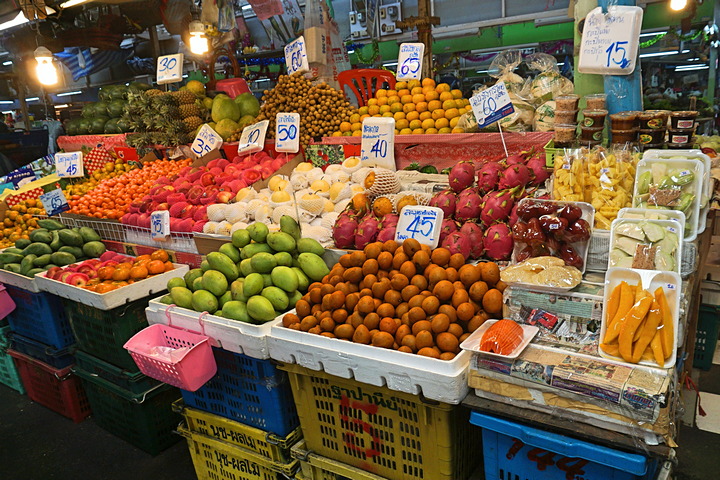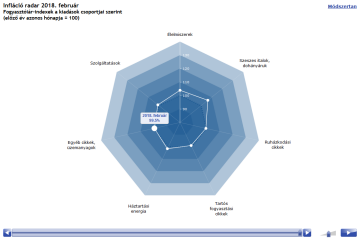Prices
The development of prices influences the quantity of production and consumption, and their structure as well. Price statistics typically observe the temporal change in the price of goods put on the market, though there are spatial price indices (e.g. purchasing power parity), too. The consumer price index quantifies changes in consumer prices, differently, producer price indices observe price changes from the point of view of producers. There are also cost-based price indices (e.g. of agriculture, labour force), which show the development of production costs over time. External trade price indices provide information on the price development of goods exports and imports.
Key figures
Change in consumer prices
Indicator description
Average change in the prices of goods and services purchased by households for own use, compared to the same period of the previous year. The consumer price index less 100 equals the change in consumer prices.
Source of data:
Summary Tables (STADAT)
Last data for period: November 2025
Change in industrial producer prices
Indicator description
Average change in the producer prices of products produced by industrial producers and of the related provided services, compared to the same period of the previous year. The prices are basic prices, not including turnover tax, consumption tax and excise duty.
Source of data:
Summary Tables (STADAT)
Last data for period: October 2025
Changes in construction producer prices
Indicator description
Average change in the prices of construction activities performed in construction, compared to the same period of the previous year.
Source of data:
Summary Tables (STADAT)
Last data for period: Q3 2025
Terms of external trade in goods
Indicator description
The price index of goods exports divided by the price index of goods imports, multiplied by one hundred. If the value of the indicator is larger than 100, then the terms of trade improved, i.e. more import goods could be purchased for a unit of export goods (or less exports than earlier on had to be provided for a unit of imports). They show the change compared to the same period of the previous year.
Source of data:
Summary Tables (STADAT)
Last data for period: 2024
Featured
HCSO Monitor
The collection of interactive figures provides up-to-date information on the latest domestic and international socio-economic trends. The decisive part of the figures included in HCSO Monitor are downloadable in both image and data formats (PNG, SVG and CSV). Feel free to browse the data in HCSO Monitor, updated many times a week!
Consumer prices 3.8% higher on average than in same month of previous year; Consumer prices, November 2025
Consumer prices were 3.8% higher on average in November 2025 than a year earlier. Compared to October, prices were 0.1% higher on average.
Industrial producer prices 0.4% higher on average in October 2025 than in previous month and 1.8% higher than a year earlier; Industrial producer prices, October 2025
Industrial producer prices were 1.8% higher on average in October 2025 than one year earlier. Domestic output prices rose by 0.9% and non-domestic ones by 2.2% compared to October in the previous year. Compared to the previous month, domestic output prices lessened by 0.1% and non-domestic output prices went up by 0.7%, so industrial producer prices as a whole were 0.4% higher.
Hungary 1st semester of 2025 – Diverging economic impacts
The performance of Hungary’s economy was identical with the one of the same period of the previous year. The increasing performance of the services sector and consumption growth had a positive impact on GDP. These impacts however have been eliminated by the setback of the industry and agriculture, the continuously subdued investment activity and the deterioration in the balance of the external trade in goods. Retail trade volume continued to rise, tourism nights spent at accommodation establishments also increased in number.
Start of School Year
In September 2025, 1.1 million students have begun their studies in various levels of initial and vocational education in full-time education, which is almost the same as the previous school year. In 2024, households with students aged 24 and younger spent an average of 45.6 thousand forints per child on starting school. Although most textbooks are available free of charge to students in initial and vocational education, the purchase of workbooks, foreign language books and publications that students wish to keep still represents additional expenses for families.
Statistical Yearbook of Hungary, 2024
The yearbook provides an overview of Hungary's demographic, social and economic trends, environmental characteristics and their changes over time, with the help of tens of thousands of data in some 500 tables, charts and maps. In the chapter devoted to earnings and incomes, it is a novelty compared to previous years that net earnings in which allowances and types of exemptions are accounted for, too, came into focus from 2019. In the number of employees, people working in working time shorter than 60 working hours per month are also taken into account. In addition, the theme of environment is completed with areas declared world heritage sites by UNESCO.
Yearbooks, pocketbooks, data repositories
A new sub-page has been added to the HCSO website, more than 400 yearbooks, pocketbooks and data collections, a total of a hundred thousand pdf format pages close to 150 thousand excel tables and several thousand static and interactive graphs and maps are available for download. The sub-page offers the possibility of filtering these yearbooks, pocketbooks and data collections by reference year, serial name, format (PDF, XLS) and supplements (graphs, maps). Users may compile their own list of publications based on the year- and pocketbooks, data collections, adequate to their interests.
Snapshots, 2024 - Prices
Consumer prices were up by 3.7% on average in 2024 compared to the previous year, and the rate of price rise significantly decreased compared to the 2023 figure (17.6%), being a 25-year peak. The deceleration in inflation was influenced by the rate of increase in industrial, construction and services prices going on lessening, and agricultural product prices going down again on average. External trade prices expressed in forints slightly rose, and minor deterioration occurred in terms of trade.
Hungary, 2024
Hungary’s GDP increased by 0.5% amid global challenges in 2024. The performance of goods-producing industries lessened, while that of service-providing ones rose, which shows the duality of economic trends. Household consumption picked up, which was considerably encouraged by the purchasing power of earnings growing again with the inflationary wave calming down. Besides, the data series reveal that the level of employment reached another peak.
Statistical Pocketbook of Hungary, 2024
The tables and charts in the latest edition of the Statistical Pocketbook of Hungary provide a comprehensive insight into the development of social and economic trends in Hungary during the year 2024. It aims to provide a summary picture of the country's situation in all possible areas based on preliminary indicators. Within the number of employees, this year's pocketbook also includes employed persons working less than 60 hours, and the gross revenues at tourist accommodation establishments.
Snapshots, 2024 – Consumer prices
Consumer prices were up by 3.7% on average in 2024 compared to the previous year, and the rate of price rise significantly decreased compared to the 2023 figure (17.6%), being a 25-year peak. It was the growth in service prices that had the largest impact on inflation, furthermore, the rise in food prices also had a substantial part, however, electricity, gas and other fuels as well as consumer durables became cheaper.
Agricultural producer and input prices, quarters 1–3, 2023
Agricultural producer prices decreased by 7.3% in quarters 1–3 of 2023, within which the price of crop products lessened by 25% and that of animals and animal products was up by 21%. The 5.4% increase in input prices was influenced by the price rises for the components of intermediate consumption and for investments, too. The price level augmented by 4.6% in the case of the former and by 12% for the latter. The value of the agricultural terms of trade was 88%.
Related themes
- Agriculture
- Construction
- Culture, sports
- External trade and balance of payments
- Housing
- Industry
- International data
- Tourism, catering
Methodological information
First releases |
Latest release | Next release |
|---|---|---|
| Consumer prices, November 2025 | 09/12/2025 | – |
| Industrial producer prices, October 2025 | 28/11/2025 | – |
Release and revision calendarPublication repertory






















